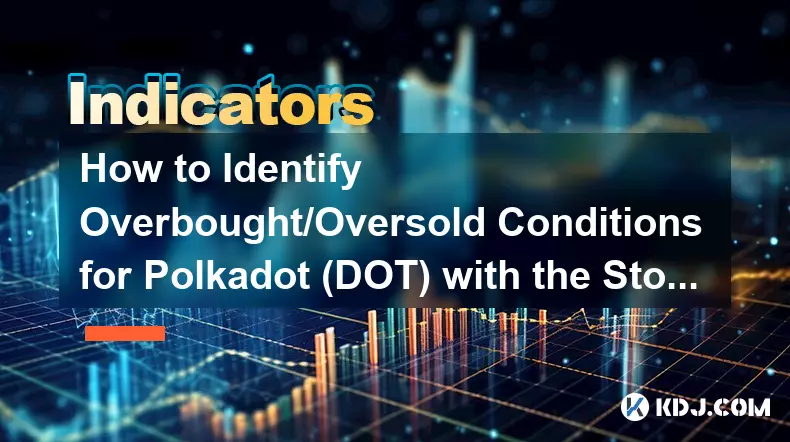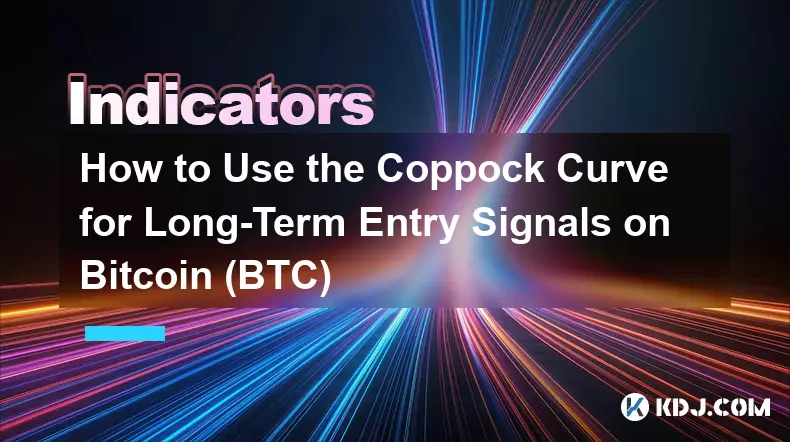-
 bitcoin
bitcoin $107015.826941 USD
-2.18% -
 ethereum
ethereum $3637.352324 USD
-5.18% -
 tether
tether $0.999831 USD
-0.02% -
 xrp
xrp $2.338078 USD
-6.23% -
 bnb
bnb $998.272150 USD
-6.97% -
 solana
solana $167.598257 USD
-10.12% -
 usd-coin
usd-coin $0.999863 USD
0.01% -
 tron
tron $0.282573 USD
-5.09% -
 dogecoin
dogecoin $0.169891 USD
-7.39% -
 cardano
cardano $0.557554 USD
-7.03% -
 hyperliquid
hyperliquid $39.914802 USD
-5.85% -
 chainlink
chainlink $15.414549 USD
-9.97% -
 bitcoin-cash
bitcoin-cash $510.361911 USD
-4.26% -
 ethena-usde
ethena-usde $0.999194 USD
-0.03% -
 stellar
stellar $0.282092 USD
-6.07%
How to Identify Overbought/Oversold Conditions for Polkadot (DOT) with the Stochastic RSI
The Stochastic RSI helps identify overbought (>0.8) and oversold (<0.2) conditions in Polkadot’s price, offering early reversal signals in volatile markets when combined with volume and on-chain data.
Oct 25, 2025 at 04:01 pm

Understanding the Stochastic RSI in Cryptocurrency Analysis
1. The Stochastic RSI (StochRSI) is a momentum oscillator derived from the standard Relative Strength Index (RSI), designed to measure the level of the RSI relative to its high-low range over a set period. Unlike traditional RSI, which typically oscillates between 0 and 100, StochRSI operates within a tighter 0 to 1 scale, making it more sensitive to short-term price fluctuations. This sensitivity makes it particularly useful for identifying potential reversal points in fast-moving markets such as Polkadot (DOT).
2. Traders use StochRSI to detect overbought and oversold conditions by observing when the indicator crosses above 0.8 or drops below 0.2. When the StochRSI value exceeds 0.8, DOT may be considered overbought, signaling that upward momentum could be weakening and a pullback might occur. Conversely, readings below 0.2 suggest an oversold condition, implying that selling pressure may have exhausted itself and a bounce could be imminent.
3. Because Polkadot's price often experiences sharp swings due to market sentiment, exchange inflows, or network upgrades, relying solely on price action can lead to delayed signals. Incorporating StochRSI allows traders to anticipate shifts before they fully materialize on the chart. It’s calculated using a formula that compares the most recent RSI value to its range over a specified number of periods, usually 14.
4. One advantage of StochRSI over plain RSI is its ability to capture rapid changes in momentum. In highly volatile environments like the DOT market, this responsiveness helps traders spot early signs of exhaustion in trends. However, due to its increased sensitivity, it can generate false signals during strong trending phases, especially if used without confirmation from other tools.
5. To improve accuracy, many traders apply a moving average—typically a 3-period simple moving average—to the StochRSI line. This smoothed version acts as a signal line, and crossovers between the StochRSI and its moving average are interpreted as potential entry or exit points. For example, a bullish crossover occurs when the StochRSI line moves above the signal line in oversold territory, suggesting a possible long opportunity.
Applying StochRSI to Polkadot Price Charts
1. When analyzing DOT/USDT or DOT/BTC trading pairs on platforms like Binance or TradingView, setting up the StochRSI with default parameters (14 periods) provides a baseline for detecting extreme levels. Zooming into 4-hour or daily charts tends to yield more reliable signals than lower timeframes, where noise can distort readings.
2. A sustained move above the 0.8 threshold on the StochRSI may indicate that buyers have pushed the price too far, too fast. For instance, during a rally following a parachain auction win, DOT’s StochRSI climbed above 0.9, preceding a 15% correction within two days. Such cases highlight how overbought signals can precede profit-taking events even amid positive news.
3. On the flip side, prolonged dips below 0.2 often coincide with capitulation phases. In late 2023, after a major exchange reported a temporary suspension of DOT withdrawals, the StochRSI dropped to 0.12, marking a clear oversold zone just before a 22% rebound over the next 48 hours. These instances demonstrate how fear-driven selloffs can create contrarian opportunities visible through oscillator analysis.
4. Divergences between price and StochRSI offer powerful clues about underlying strength. If DOT reaches a new high but the StochRSI fails to surpass its prior peak, this bearish divergence suggests weakening momentum. Similarly, if the price hits a lower low while StochRSI forms a higher low, it indicates hidden buying interest building beneath the surface.
5. Multiple confirmations increase reliability. Combining StochRSI extremes with volume spikes, support/resistance breaks, or on-chain metrics like exchange netflow can filter out misleading signals. For example, an oversold StochRSI reading accompanied by declining exchange reserves strengthens the case for accumulation.
Managing Risks When Trading DOT Using StochRSI Signals
1. False signals are common in trending markets. During strong bull runs, StochRSI can remain overbought for extended periods, leading premature short attempts to fail. In early 2024, DOT stayed above the 0.8 level for nearly ten consecutive days during a surge fueled by ecosystem grants, trapping traders who acted solely on overbought readings. This illustrates the danger of counter-trend trades without considering broader market context.
2. Position sizing should reflect the probabilistic nature of oscillator-based strategies. Instead of allocating full capital on a single StochRSI signal, traders might initiate partial entries and scale in based on follow-through. Setting stop-loss orders just beyond recent swing points helps contain losses if the expected reversal doesn’t occur.
3. Timeframe alignment improves decision-making. A trader might use the daily StochRSI to determine bias—such as avoiding shorts when the daily reading isn't clearly overbought—and then look to the 4-hour chart for precise entries. This multi-timeframe approach reduces whipsaw exposure.
4. External catalysts can override technical patterns. Upcoming events like governance votes, parachain lease expirations, or cross-chain integrations may trigger volatility that invalidates typical oscillator behavior. Monitoring project announcements alongside technicals ensures traders aren’t caught off guard by fundamental shocks.
5. Backtesting historical DOT data enhances strategy refinement. By reviewing how StochRSI performed across different market regimes—ranging from consolidation phases to parabolic rallies—traders gain insight into optimal parameter adjustments and filtering rules specific to the asset’s behavior.
Frequently Asked Questions
What is the ideal period setting for StochRSI when analyzing DOT?The default 14-period setting works well for most scenarios. Shorter periods like 9 increase sensitivity and suit scalping strategies, while longer settings like 21 reduce noise for swing traders focusing on higher timeframes.
Can StochRSI be used alone to trade Polkadot profitably?Relying solely on StochRSI carries significant risk due to false signals in trending markets. It performs best when combined with trend filters, volume analysis, or on-chain data to validate entries and exits.
How does StochRSI differ from regular RSI in spotting reversals?StochRSI measures the position of RSI within its recent range, making it more reactive to immediate changes in momentum. Regular RSI identifies overbought/oversold zones more slowly, whereas StochRSI highlights them faster but with less stability.
Does StochRSI work effectively during low-volume periods for DOT?Its effectiveness diminishes during low liquidity phases, as thin order books amplify price wicks and cause erratic oscillator movements. Waiting for volume confirmation improves signal quality during such times.
Disclaimer:info@kdj.com
The information provided is not trading advice. kdj.com does not assume any responsibility for any investments made based on the information provided in this article. Cryptocurrencies are highly volatile and it is highly recommended that you invest with caution after thorough research!
If you believe that the content used on this website infringes your copyright, please contact us immediately (info@kdj.com) and we will delete it promptly.
- XRP, BlockDAG, and Presales: Decoding the Hottest Crypto Trends
- 2025-11-04 22:50:12
- $PLAI Token Set to Launch on KuCoin: Mainnet Goes Live!
- 2025-11-04 23:10:02
- Moonwell's Oracle Exploit: A Wake-Up Call for DeFi Price Feeds
- 2025-11-04 23:05:01
- Chainlink (LINK) Crypto Explosion: Will It Hold or Fold?
- 2025-11-04 23:10:14
- Nature's Miracle, Super Point, and Stablecoin: A New Era for Loyalty Rewards?
- 2025-11-04 22:40:02
- ADA Slowdown, Maxi Doge, and the Meme Coin Mania: What's the Hype?
- 2025-11-04 20:50:12
Related knowledge

Technical analysis for crypto: using RSI and MACD to find trading signals.
Nov 03,2025 at 03:18pm
Decentralized Exchanges Are Reshaping Trading Dynamics1. Decentralized exchanges (DEXs) have gained significant traction by eliminating intermediaries...

The Best Exponential Moving Average (EMA) Settings for Crypto Swing Trading
Oct 25,2025 at 04:55pm
The Best Exponential Moving Average (EMA) Settings for Crypto Swing TradingSwing trading in the cryptocurrency market relies heavily on identifying tr...

How to Use the Coppock Curve for Long-Term Entry Signals on Bitcoin (BTC)
Oct 31,2025 at 03:01pm
Understanding the Coppock Curve in Bitcoin Analysis1. The Coppock Curve is a momentum indicator originally designed for stock market indices but has f...

A Beginner's Guide to Finding Divergence with the MACD on the Solana (SOL) Chart
Oct 26,2025 at 12:36pm
Understanding MACD and Its Role in Solana Trading1. The Moving Average Convergence Divergence (MACD) is a momentum indicator widely used in cryptocurr...

How to Use the Aroon Indicator to Identify New Trends in Cardano (ADA)
Oct 26,2025 at 10:18pm
Understanding the Aroon Indicator in Cryptocurrency Trading1. The Aroon indicator is a technical analysis tool designed to identify whether an asset i...

Trading the Ichimoku Cloud "Kumo Twist" for Ethereum (ETH) Reversals
Oct 27,2025 at 01:54am
Understanding the Ichimoku Cloud and Its Components1. The Ichimoku Cloud, also known as Ichimoku Kinko Hyo, is a comprehensive technical analysis tool...

Technical analysis for crypto: using RSI and MACD to find trading signals.
Nov 03,2025 at 03:18pm
Decentralized Exchanges Are Reshaping Trading Dynamics1. Decentralized exchanges (DEXs) have gained significant traction by eliminating intermediaries...

The Best Exponential Moving Average (EMA) Settings for Crypto Swing Trading
Oct 25,2025 at 04:55pm
The Best Exponential Moving Average (EMA) Settings for Crypto Swing TradingSwing trading in the cryptocurrency market relies heavily on identifying tr...

How to Use the Coppock Curve for Long-Term Entry Signals on Bitcoin (BTC)
Oct 31,2025 at 03:01pm
Understanding the Coppock Curve in Bitcoin Analysis1. The Coppock Curve is a momentum indicator originally designed for stock market indices but has f...

A Beginner's Guide to Finding Divergence with the MACD on the Solana (SOL) Chart
Oct 26,2025 at 12:36pm
Understanding MACD and Its Role in Solana Trading1. The Moving Average Convergence Divergence (MACD) is a momentum indicator widely used in cryptocurr...

How to Use the Aroon Indicator to Identify New Trends in Cardano (ADA)
Oct 26,2025 at 10:18pm
Understanding the Aroon Indicator in Cryptocurrency Trading1. The Aroon indicator is a technical analysis tool designed to identify whether an asset i...

Trading the Ichimoku Cloud "Kumo Twist" for Ethereum (ETH) Reversals
Oct 27,2025 at 01:54am
Understanding the Ichimoku Cloud and Its Components1. The Ichimoku Cloud, also known as Ichimoku Kinko Hyo, is a comprehensive technical analysis tool...
See all articles










































































